How to work with the fixed stars in astrological chart
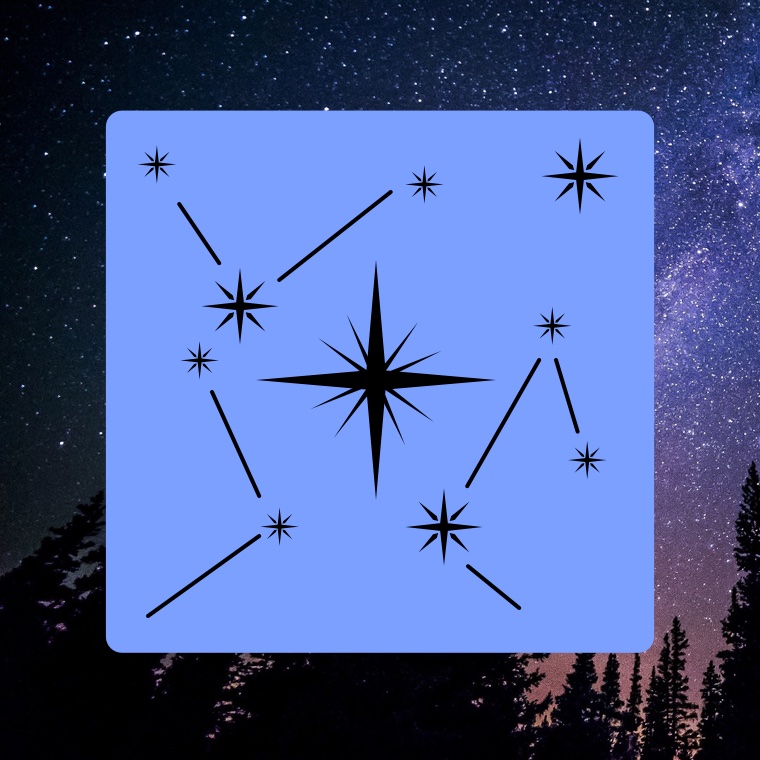
Fixed stars astrology adds an extra layer of precise information to your natal chart or any other astrological chart for specific time and place. Learn how to work with the fixed stars using Time Nomad — enrich your chart interpretations with very specific knowledge of stellar influences.
Time Nomad offers a “Fixed Stars” tool that was carefully designed to be a valuable calculator of the fixed stars zodiacal positions and their aspects with planets and points on any astrological chart.
The fixed stars calculations and interpretations bring a wealth of astrological insights that are of immense help to any practicing astrologer — from beginner to professional.
The fixed stars hold the key to precise chart interpretation
The point-like nature of the fixed stars allows for some very precise observations when it comes to working with natal charts.
Unlike the planets whose energies are of a more diluted and dispersed nature, the fixed stars express themselves via sharp and forceful astral energies that are always specific to the chart’s time and geographic location.
Analysing the fixed stars, the astrologer may uncover some previously unknown and unsuspected influences that were very difficult to explain just by working with the planets alone.
A fixed star can easily modify energetic profile of a planet in ways that could potentially confuse both the astrologer and their client:
“How come my Moon feels so fiery, against everything I’ve been told about watery nature of the Moon?”
To answer questions like that, the astrologer should analyse the position of the Moon relative to the fixed stars, and see if any stellar influences were at play. The energy of the Moon can be easily modified by its conjunction to stars like Regulus, Antares or Aldebaran — all of them are of fiery Mars-like nature… but each with a certain twist.
Categories of fixed stars
The fixed stars astrology recognises several categories of stars, each group has its own value and interpretation. Knowing to what category some specific star belongs allows for a more meaningful interpretation of its actions.
Let’s quickly go over the major three categories…
15 Behenian stars
Those are the most powerful and influential fixed stars known since ancient times. The word “behenian” originates from Arabic bahman meaning “root”. The fifteen Behenian stars were extensively used in astrology and magical practices. Each of the stars is assigned some key properties:
- gemstone
- plant
- kabbalistic symbol
Those fifteen stars are more or less evenly distributed along the zodiacal circle. The illustration below shows Time Nomad chart with Behenian stars placed along the Zodiac.
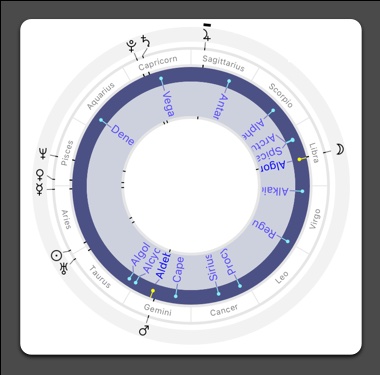
The table below lists fifteen Behenian stars and their properties.
| Star | Constellation | Stone | Herb | |
|---|---|---|---|---|
| 1 | Algol | Perseus (beta) | Diamond | Black hellebore, mugwort |
| 2 | Alcyone (the Pleiades) | Taurus (eta) | Rock crystal | Fennel |
| 3 | Aldebaran | Taurus (alpha) | Carbuncle or ruby | Milky thistle |
| 4 | Capella | Auriga (alpha) | Sapphire | Horehound |
| 5 | Sirius | Canis Major (alpha) | Beryl | Savine, juniper |
| 6 | Procyon | Canis Minor (alpha) | Agate | Heliotrope |
| 7 | Regulus | Leo (alpha) | Granite | Celandine |
| 8 | Alkaid | Ursa Major (eta) | Magnet | Chicory |
| 9 | Algorab | Corvus (delta) | Onyx | Burdock |
| 10 | Spica | Virgo (alpha) | Emerald | Sage |
| 11 | Arcturus | Bootes (alpha) | Jasper | Plantain |
| 12 | Alphecca | Corona Borealis (alpha) | Topaz | Rosemary |
| 13 | Antares | Scorpius (alpha) | Sardonyx, amethyst | Birthwort |
| 14 | Vega | Lyra (alpha) | Chrysolite | Savory |
| 15 | Deneb Algedi | Capricornus (delta) | Chalcedony | Marjoram |
Analysing aspects of Behenian stars is the first logical step when looking at any astrological chart.
Galaxies, nebulae, clusters and other Messier objects
The second type of fixed stars are not really “stars” but rather huge formations consisting of many stars. They are commonly known as Messier objects in modern astronomy.
Time Nomad supports several major Messier objects, the illustration below shows their positions on the Zodiac.
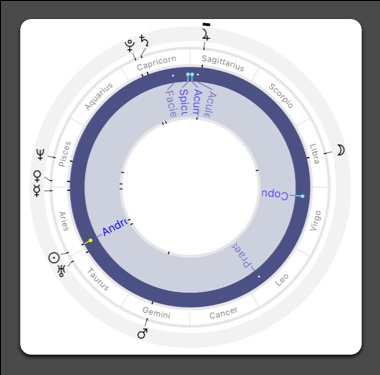
Ancient astrologers held a rather negative view about objects like nebulae, associating their quality of nebulosity with blindness and other physical defects. This is perhaps a somewhat outdated view. In the modern astrological parlance nebulosity can be translated into weak sight, lack of discernment and indecisiveness in general.
Other stars of significant influence
Time Nomad comes with about 85 other stars that are all proper physical stars qualities of those were been described by the ancient astrologers. Well known and influential stars like Achernar, Altair, Canopus, Castor, Pollux, Rigel, Betelgeuse belong to this category.
These stars are also very important for astrological analysis, especially when they rise above the horizon, about to set or culminate.
What stars are the most important?
A general rule is that a brighter the star that is close to the plane of ecliptic would have a very strong influence on any planet it aspects.
Aspects that the star forms with the planets or cardinal points of the chart is another indicator of its influence strength. And as with regular aspects between the planets, the smaller the orb of the aspect, the stronger that fixed star influence is.
What aspects can fixed stars have?
The fixed stars aspects is the topic of debates. The most accepted point of view that the stars can only form conjunctions because “stars cast no rays” as per traditional astrological point of view.
But from the standpoint of geometry, any aspect is possible. It’s a matter of personal preference and knowledge of working with the fixed star aspects.
Time Nomad allows to work with any aspects, both major and minor. The illustration below shows the app settings where the user can select stellar aspects they wish to calculate.
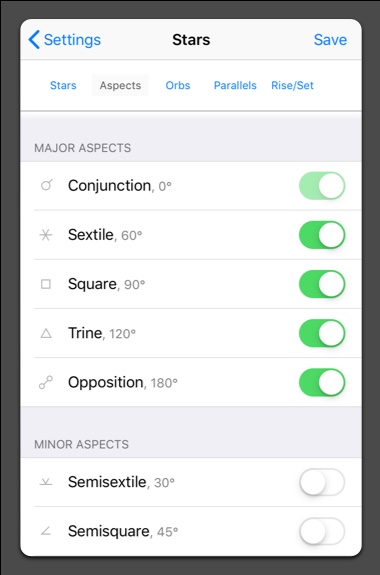
Viewing aspects to the fixed stars
In order to visually inspect aspects to the fixed stars, head over to “Chart for now” or “Natal chart” screens where you can activate the stellar ring and also turn on aspects to the fixed stars using the popup under “Show” menu.
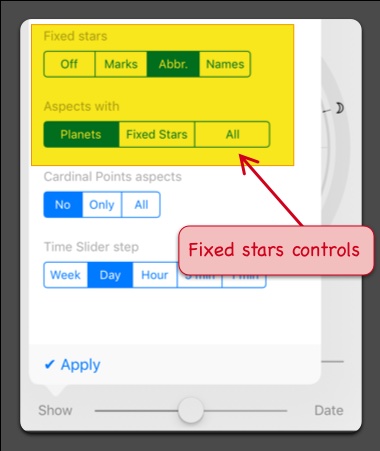
Once the stellar aspect turned on, their connecting lines will be displayed on the chart, just like regular aspects.
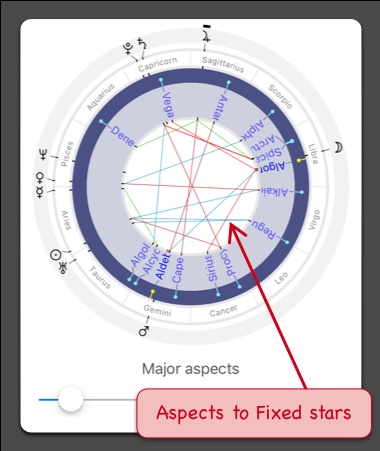
The wheel chart provides a good overview of the aspects but if you need to see the aspects in a list format, head over to “Fixed stars” or “Natal fixed stars” screens that provide a rich reporting functionality.
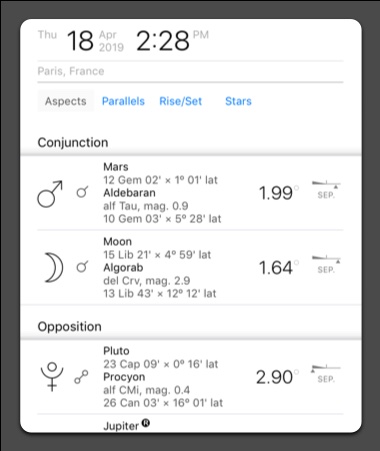
In addition to aspects, the reports also contain parallels to the fixed stars. Time Nomad doesn’t offer contra-parallels to the fixed stars as they don’t seem to carry much astrological weight.
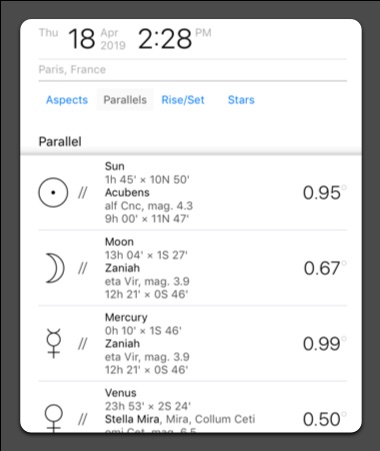
Fixed stars specific to chart geographic location
What makes a unique chart is its precise geographic location as well as time. Once astrologer knows those parameters, they can calculate positions of the fixed stars as seen from that specific place on the Earth.
The most important are those stars that are:
- rising above the horizon
- culminating by crossing the local meridian
- setting below the horizon
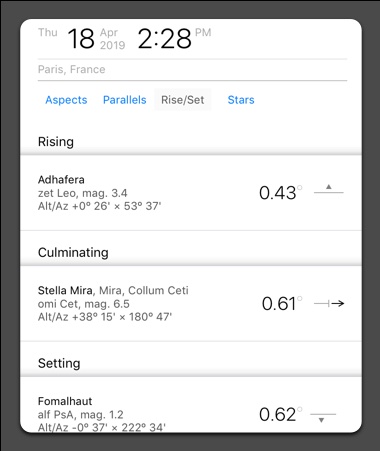
The most significant influence is attributed to rising and culminating stars. Setting stars give much more subtle and nuanced clues to their influence. Culminating star signifies maturation and maximum of unfoldment of its energies. Rising star brings a youthful punch and sets the dynamic direction for the chart.
Filtering the reports
Every listing — be it aspects, parallels, rise-culmination-set or general star informations — can be further filtered and customised by tapping on the “Show” button.
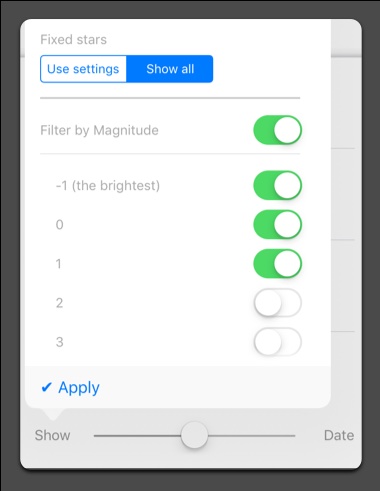
The popup menu allows to exclude or include stars by their magnitude as well as to choose if you want to work with the pre-selected set of stars (as per app settings) or the whole available list of the fixed stars.
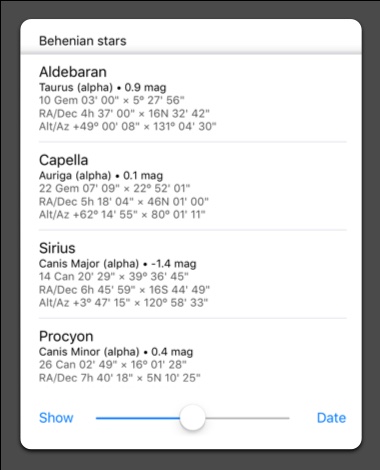
The filtering functionality helps to narrow down the search, for example, if only stars of certain magnitudes are of interest.
45 Comments
DANIEL
when I was born aldebaran uranus and sol lined up on nine gemini opposing alpha scorpius at 9 sagittarius but saturn conjunct Belteguese at 27 Gemini and 27 is another nine also Mars conjunct Pluto and looking at the chart you notice URANUS DOMINANT OCCULTATION SUN RISING but fixed stars t Aldebaran and Antares get into the mixture I do attract attention and have mental powers.
I was also a prenatal abductee my mother got her space trip while pregnant with me inside her this has developed a history an offer of a military posting with Reptilians.
iame Dey
Hey Daniel! I was born May 31st 1982, 8:06 pm in St. Louis Missouri. Alderbaran was at 10° Gemini descendant with Sun and Mercury at 11° Gemini all somewhat opposing Antares rising at 9°. I’ve been trying to contact someone who has a line up as close as mine and now I’ve found you. curtistaylor581@gmail.com contact me!
Amy
Am I supposed to use Tropical or Sidereal for fixed stars?
Time Nomad
It doesn’t matter. Fixed stars are simply “points”. You can use tropical or you can use sidereal, whichever your prefer. Fixed stars are better aligned with the sidereal zodiac, for example Antares (of Scorpio) will be in the Scorpio sign in the sidereal zodiac but in Sagittarius in the tropical zodiac. But that won’t influence anything else.
Dora Moura
HISTÓRIA MUITO INTERESSANTE, DANIEL. NÓS ACREDITAMOS MUITO NISSO TUDO. NÃO SE PREOCUPE.
pat Bradshawe
This sounds fascinating in the light of all that is coning to light in the revealtions of space and alien contacts. I hope it augers well for you .
maria
This has nothing to do with your idea of aliens etc .
Lambswing@gmail.com
Does the moons degrees count? My moons in Leo 29’39 degrees. And it’s my understanding that that means I have the fixed star Regulus. Is this correct? Also my understanding is that the you can still have a fixed within 1or 2 degrees. Is this accurate? Thank You!
Tiffany
Yes your moon is conjunct exact with Regulus. My vertex is conjunct with Regulus with a 1 degree orb.
Tiffany
Thank you for this helpful information. I noticed that Alpha Crucis is listed in the graphic of the 15 Behenian stars (I think? It’s whited out a bit but I see it at about 14 degrees in Scorpio). But I don’t see Alpha Crucis or its constellation (southern cross or crux) in the following table. Is there a reason for this? Thank you!
Melvin
I don’t know if you’re familiar with Harmonic charts or Vargas but they divide the natal chart signs by degrees according to their corresponding number. I was just wondering, do you think the locations of fixed stars stay fixed in those charts?
Time Nomad
I understand harmonics and think it’s a fascinating direction for research and new ideas. I’d recommend books of John Addey, for example, Harmonic Anthology. Don’t recall him mentioning fixed stars much. The main thing to remember with harmonics is that the higher number you go the more error you get – imprecision of birth time grows very fast as one approaches the 20th harmonic.
Technically speaking, nothing prevents us from applying harmonics to the stars. There may be some interesting results. That probably makes sense in cases of a star to planet conjunctions. Yet individual stars don’t really relate to the Zodiac signs the same way as the planets do, there’s always a risk of not getting meaningful information out of their harmonics.
Dagne
I was born with Ankaa star conjunct my natal sun (it was in night time), does that mean anything?
Time Nomad
Ankaa is a rather far from the ecliptic, about 40º away. Given the conjunction was at night time, it’s likely to be related to something deeply subconscious and not necessarily easy to grasp with our ordinary daytime logic. See other conjunctions, and perhaps stargaze on the star itself. This may give you a certain feeling you can pursue further.
Rylee
I wish I could get a report but I dont have an iPhone to download the app. Is there another way to get a thorough report? I know that aldebaran is exact conjunct my sun and Antares is exactly conjunct my Jupiter. But I really want to look into a full report and all aspects. Any suggestions? Or news on whether and when this app will be available on android?
Time Nomad
Firstly, the app doesn’t create reports along the lines of “what does it mean in the case of my chart”. It only gives a general narrative about specific aspects. I can refer you to the book The Fixed Stars And Constellations in Astrology by Vivian E. Robson… but still it only gives a generic descriptions which may be quite cryptic. A better approach is to work with a human astrologer who understands the fixed stars.
As for the Android version, no plans for the foreseeable future. I am a solo developer and maintaining the app for just one platform takes all my time.
J9
Hi Rylee! Before I downloaded Time Nomad [or even knew it existed] I found Claudio Silvaggi on YouTube and with a few details provided by me, he prepared my sidereal Natal chart for free and emailed me the details of it. What a WOW–that was!!! He also offers You a follow-up ZOOM session [optional and free too] to answer any questions You may have and clarifies any significance in Your Natal chart. He has a YouTube channel full of videos related to sidereal astrology. He also has at least one video about astrology apps. It Helped me decide for Time Nomad as I have an iPhone. Swift & direct wishes as You Journey on the path to Self knowledge! J9
Sunny
Do you have an app for Android users? I’m trying to calculate and interpret my fixed stars and my friends.
Time Nomad
At this stage the app is iPhone/iPad only. No plans for an Android version yet.
Ledecka Tereza
Do only personal planets count? My Pluto is conjunct Spica…Does it count?
Time Nomad
Any planet counts. The most important factor is how tight the conjunction is. Spica is one of the most significant stars, it is positioned right on the ecliptic.
Pluto has a rather high inclination of 17º, ie it travels up and down with relationship to the ecliptic. The closer it was to the ecliptic the more powerful that stellar conjunction is expected to be.
In any case, Pluto and Spica conjunction has an important influence on the chart.
Fana
Hello, Time Nomad
What happens if you have Vega exactly conjunct Capricorn rising, Cancer Descendant conjunct Sirius, and Pluto Conjunct Arcturus/Spica, at 23 degrees Libra, part of a Libra stellium (Mercury, Jupiter, Saturn, Pluto)? Do these influences contradict each other? And another question, are the houses in which the planets conjunct fixed stars are important as well? Cause Pluto is in my 9th house, in Placidus House system, but in my 10th in Whole House System. I do not recall extraordinary things to happen in my life, that is why I am confused.
Thank you!
Time Nomad
Always look at the star proximity to the ecliptic. Vega and Sirius are rather far, so they won’t have as strong influence as Spica conjunct Pluto which I’d say is the strongest influence. I personally prefer the Placidus system as it’s more sophisticated since it works with time segments as opposed to a much more simpler Whole House system. The 9th house points at long studies/journeys and having Pluto/Spica there would give hints at deepening your life work using learning opportunities.
Ziana
Hello! I have Vega conjunct my ascendant 15 degrees with Spica conjunct my MC at 23 degrees. What would that mean?
Time Nomad
Vega is a bit too far from the ecliptic (61º latitude) so its influence may not be prominent. Spica is another thing as it sits very close to the ecliptic. I’d point at things like using clarity and discernment in daily affairs. Things one does have to be truthful.
Erika Brooks
Hi, I have Time Nomad and am interested in adding the fixed star tool to it. I looked in the app store and on this website, yet i can’t find out how to get it. Thanks in advance for your assistance
Time Nomad
Time Nomad currently supports the most prominent 107 fixed stars. I will add more stars in the future if so needed. If you have some stars in mind, please email me using the “Contact developer” option in the app (top left corner, under the cogwheel icon menu).
Genevieve
hello ! thanks for info. if you have time please let me know what would be meaning of having HR as Acubens, HS as altair, are they significant, or ‘stars rising’ has more meaning more or less?
i.e. i have Stars Rising - sun: jupiter(Set-rise) Rukbat(Set-rise), Ankaa(LCul-Rise)
does it have strong influence on my current incarnated life than HS/HR?
Time Nomad
The best way to find out is to do extended star gazing, ie an eye contact with the star. Acubens is very vary faint though, hard to see.
The other factor to consider is how far the star from the ecliptic. Acubens is about 5º which is relatively close but Altair is about 29º which is quite far.
Nevertheless, spend time gazing at those stars and see what you feel. The experiential pathway is the easiest when it comes to the fixed stars.
Juniper
Do you have any sources for delineating a chart, particularly an unfortunate chart that, has several of the major fixed stars strongly aspected? I have so many, but now in my second half of life have not experienced the benefits. Only poverty, chronic lack of recognition and bad luck, endless bully boy narcissists salivating for my death and ill health. Life is essentially a sixth house hell hole. Sun conjunct Regulus Moon conjunct Antares MC conjunct Fomalhaut Mars conjunct Spica Venus conjunct Sirius/Ascendant Saturn conjunct Alkaid
Time Nomad
It could be not an unfortunate chart but rather misunderstood one. Things like that could happen when one somehow chooses to avoid doing what really needs to be done and therefore finds themselves in a perceived cul-de-sac. A certain reframe of attitude and incentives is required. Charts aren’t fixed in terms of good/bad, they are hints to the native to discover their own unique path that approaches challenges in a creative way.
Stars that are too far from the ecliptic aren’t really conjunct in a classical meaning of the word: Fomalhaut and Alkaid can be safely ignored.
This leaves Regulus, Antares and Spica as the main influences. Perhaps less fighting and more harmonising can open up new venues. There’s power there but all powers require great intelligence and perseverance, they don’t come easy or automatic. It’s a call for deep self exploration.
SarahH.
Hello there!
Thank you for this awesome explanation. Can you tell me whether fixed stars can also apply if in conjunction with houses? I have several but I don’t know if it is relevant to my chart.
Thank you!
Time Nomad
It could be helpful to see the fixed stars as sources of astral energies. So are the planets of the Solar system. The influence of a star comes through a resonance between the light of the star and the light of the planet — at the time of their visible conjunction. You can see that in the night sky yourself, just do some stargazing.
Cusps of houses are hypothetical points that don’t radiate any energy or light. It’s unlikely they will have any significant resonance with stars… with the exception of the angles (Asc, Dsc, MC and IC) as those are fundamental points delineating the celestial sphere.
Mara
I have a question about rising stars. What does it exactly mean when we say a star is “rising”? I thought that rising meant closer to the ascendant (or over the ascendant). For example, I have the star Regulus very close to the ascendant degree. But I look at the “rise/set” tab report in the app add-on, it only shows me the star Markeb as rising, which is in the same sign as the ascendant, but very far from the ascendant degree, and under the horizon. Why is it only Markeb considered rising, and not Regulus? The same goes for another chart that I was looking at: Sirius is exactly on the ascendant degree, but it only shows Pollux as a “rising” star. Thanks!
Time Nomad
Rising/setting stars are to be understood in terms of the altitude/azimuth coordinate system. This relates to the 24 hour rotation of the earth where some stars rise and some set with respect to the visible horizon for given geographic location. Rise/set are not related to the ecliptic.
The rising star is the one that is crossing the zero altitude in negative to positive direction. The setting star has the opposite movement. All with respect to the current horizon.
violet
I was born during a solar eclipse with my sun and moon conjunct 9° gemini (aldebaran) but with my north node at 29° taurus (alcyone), how would this be interpreted?
Time Nomad
The New Moon at Aldebaran. Solar eclipse due to conjunction to the nodes. The north node is at Pleades. One can think of life where new beginnings are important and transformative. The values of generosity and optimism would pave the way forward. Identifying old behavioural patterns and moving away from them is crucial.
Christophe
Hi, does Time Nomad supports Messier object M44 (beehive cluster) ? Thank you for your response ! Christophe.
Time Nomad
Yes, it does support Praesaepe / Beehive cluster / M44.
Ilaria
Hi!I recently discovered about the fixes star ( I read about the transit of Algol) and I am searching for an astrologer that includes the fixed star. Do u know someone valid? Thank u :)
Time Nomad
The fixed stars are tricky indeed! I don’t know of anybody specific who I may say is proficient with them. From my personal experience these two practical things help:
This way you can build your own relationship with the star in question. Asking somebody to do that work for you won’t necessarily bring deep insights.
Rob Hart
Is there a book which interprets ?delineates stars. & Their planetary contacts ?
Time Nomad
Fixed stars is the hardest thing to interpret. There are numerous books written on the topic yet it always feels like the star elude any human quantisation. I have previously mentioned the book The Fixed Stars And Constellations in Astrology by Vivian E. Robson, it’s a good work to illustrate how immensely complex the field is. In my opinion, the best way is to build your own experience through stargazing and careful observations. It takes time but it’s a fascinating journey that no book can match.
Asman
Salut, je veux connaître mon étoile fixe dominante pouvez-vous m’aider merci
Time Nomad
Translating the question: Hi, I want to know my dominant fixed star, can you help me? Thanks
Well, there’s no single dominant star. It all depends on which planets, if any, are conjunct to certain fixed stars. There may be none. Also, if there’s a rising/setting star or stars conjunct to MC/IC they can be candidates as well.